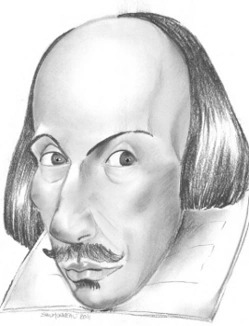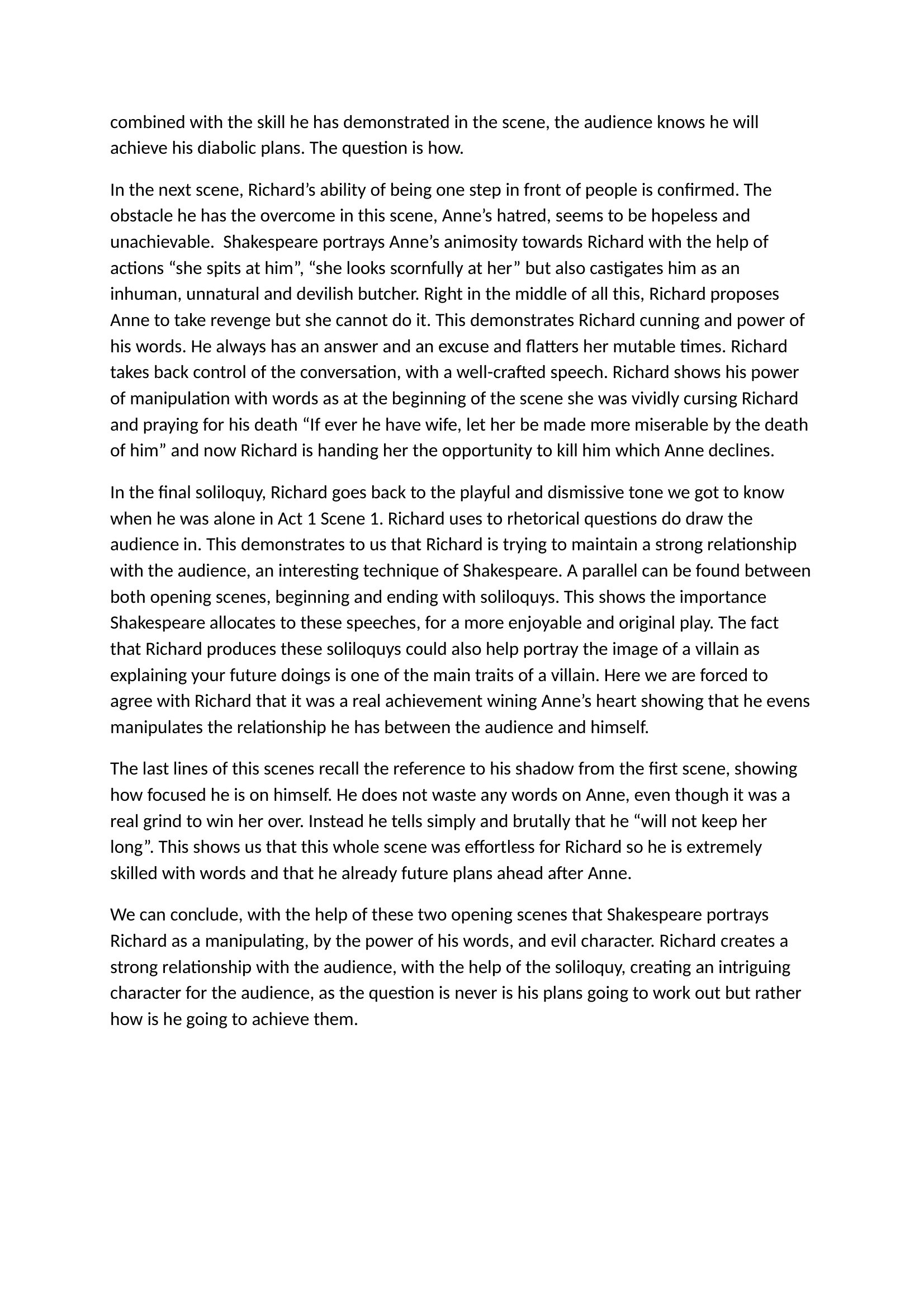How does Shakespeare establish the character of Richard in the first two scenes’ of Richard the III?
Publié le 19/11/2015

Extrait du document

Essay How does Shakespeare establish the character of Richard in the first two scenes’ of Richard the III? The first two opening scenes of Richard III create a clear image in the readers mind of Richard’s character both physically and personality. The play begins with a soliloquy e of Richard addressed to both to himself and the audience. A description of Richard the Third physical form is given in this opening speech, “Deformed, Unfinished”. Shakespeare establishes right at the beginning of the play that Richard III was not known for his looks, and bitterly laments his bad luck? Richard’s opening speech also gives a large amount of insight in the complexity of his character. He explains why happiness is impossible for him: In part because he believes that he can’t be sexually successful with women which is linked to his deformity (Shakespeare exploits the myth of Richard the Third being deformed to create a more compelling character) « herefore since I cannot prove a lover / to entertain these fair well-spoken days”. Because of this he explains that he soul objective is to ruin these merry times “&...

«
combined with the skill he has demonstrated in the scene, the audience knows he will
achieve his diabolic plans.
The question is how.
In the next scene, Richard’s ability of being one step in front of people is confirmed.
The
obstacle he has the overcome in this scene, Anne’s hatred, seems to be hopeless and
unachievable.
Shakespeare portrays Anne’s animosity towards Richard with the help of
actions “she spits at him”, “she looks scornfully at her” but also castigates him as an
inhuman, unnatural and devilish butcher.
Right in the middle of all this, Richard proposes
Anne to take revenge but she cannot do it.
This demonstrates Richard cunning and power of
his words.
He always has an answer and an excuse and flatters her mutable times.
Richard
takes back control of the conversation, with a well-crafted speech.
Richard shows his power
of manipulation with words as at the beginning of the scene she was vividly cursing Richard
and praying for his death “If ever he have wife, let her be made more miserable by the death
of him” and now Richard is handing her the opportunity to kill him which Anne declines.
In the final soliloquy, Richard goes back to the playful and dismissive tone we got to know
when he was alone in Act 1 Scene 1.
Richard uses to rhetorical questions do draw the
audience in.
This demonstrates to us that Richard is trying to maintain a strong relationship
with the audience, an interesting technique of Shakespeare.
A parallel can be found between
both opening scenes, beginning and ending with soliloquys.
This shows the importance
Shakespeare allocates to these speeches, for a more enjoyable and original play.
The fact
that Richard produces these soliloquys could also help portray the image of a villain as
explaining your future doings is one of the main traits of a villain.
Here we are forced to
agree with Richard that it was a real achievement wining Anne’s heart showing that he evens
manipulates the relationship he has between the audience and himself.
The last lines of this scenes recall the reference to his shadow from the first scene, showing
how focused he is on himself.
He does not waste any words on Anne, even though it was a
real grind to win her over.
Instead he tells simply and brutally that he “will not keep her
long”.
This shows us that this whole scene was effortless for Richard so he is extremely
skilled with words and that he already future plans ahead after Anne.
We can conclude, with the help of these two opening scenes that Shakespeare portrays
Richard as a manipulating, by the power of his words, and evil character.
Richard creates a
strong relationship with the audience, with the help of the soliloquy, creating an intriguing
character for the audience, as the question is never is his plans going to work out but rather
how is he going to achieve them..
»
↓↓↓ APERÇU DU DOCUMENT ↓↓↓
Liens utiles
- RICHARD III de William Shakespeare
- Nixon's Resignation Speech Nixon's Resignation Speech August 8, 1974 Richard Milhous Nixon was the first United States president in history to resign from office.
- Shakespeare, Richard III (extrait) - anthologie du théâtre.
- Diego Velázquez (artist) I INTRODUCTION Velázquez and Baroque Theatricality Spanish painter Diego Velázquez presents two scenes in The Fable of Arachne (about 1656, Museo del Prado, Madrid, Spain), also known as The Spinners.
- Richard III [William Shakespeare] - Fiche de lecture.







